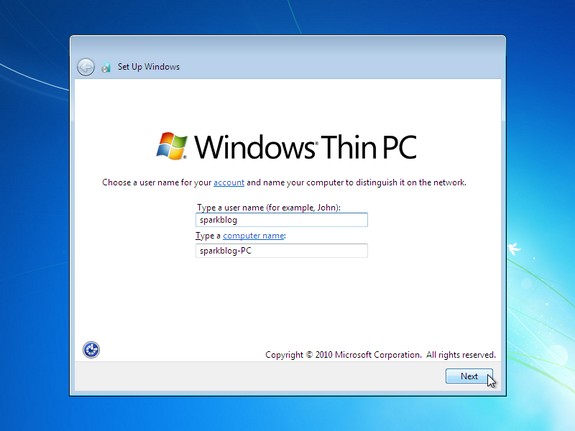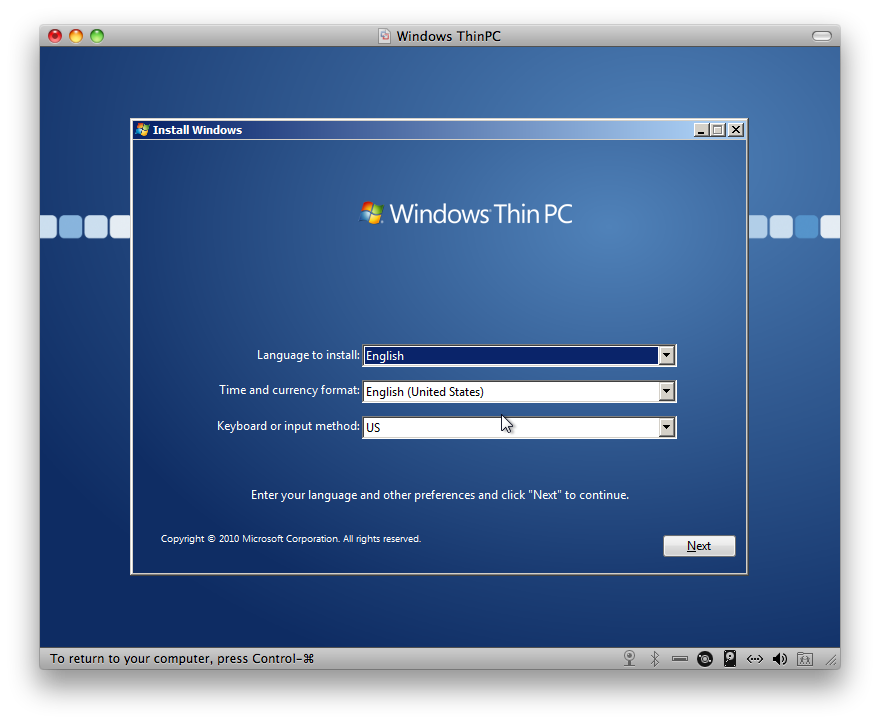Windows 7 Thin Pc
Windows 7 may be among the most popular operating systems in the world, but it is definitely not the slimmest one, as it comes loaded with numerous apps and settings that are not absolutely necessary for the smooth running of a computer. Companies that are looking for an OS with a smaller footprint can try Windows Thin PC. This utility comes as an ISO so it should only be managed by IT personnel who have the proper knowledge to correctly deploy it to remote machines delivered via Microsoft Virtualization Desktop Infrastructure or sessions. This slim client solution provides companies with the possibility to enhance the security and compliance levels, as users can rely on write filters so as to prevent data from being written to disk.
Windows 7 Thin Pc Key

Additionally, Windows Thin PC provides users with support for remote desktop connections so they can deliver hi-fi multimedia data from centralized locations. As it is especially developed to meet business requirements, IT personnel can resort to existing System Center instances to manage Windows Thin PC, and they can also deploy programs, security patches and even updates. They can also use BitLocker and AppLocker to increase the protection and security of their repurposed PCs, as well as rely on DirectAccess to provide their clients with secure access to their slimmed down laptops. All in all, Windows Thin PC can help companies evaluate the benefits of the slim client computing, and if they are pleased with the functionality, they can purchase a full-blown solution after the evaluation period expires. Furthermore, if they are not satisfied with the functions provided by thin client computing, IT admins can easily revert to traditional computers after having installed Windows Thin PC on their machines.
There’s still a lot of work to be done with Windows 7. Allow system admins to configure and manage the thin-client devices. Windows Thin PC: Microsoft's.
Windows 7 Thin Pc Sp1
By the end of March 2011 Microsoft will offer the first taste of a new version of Windows 7 tailored to the needs of customers with virtual desktop infrastructure (VDI) environments. Windows Thin PC (WinTPC) will make its debut into a broader testing phase no later than next month, with, the General Manager for the Windows Commercial business, revealing that the bits will be served through Microsoft Connect. At this point in time, the Redmond company did not provide a specific availability deadline for Windows Thin PC, but Schuster promised that downloads of the new Windows 7 SKU will go live in later in the first quarter of 2011 (Q1 2011). “WinTPC is a smaller footprint, locked down version of Windows 7, designed to allow customers to repurpose their existing PCs as thin clients. “PCs with WinTPC will not require the VDA license that regular thin clients will need to access VDI desktops,” Schuster added. The software giant also did not announce a price tag for Windows Thin PC, and the reason for this is rather simple.
WinTPC will be a SA benefit. This means that customers with Software Assurance license agreements with Microsoft will not have to pay for extra licenses in order to leverage WinTPC with their PCs/thin clients. SA customers already don’t have to pay extra for separate licenses designed to enable them to access Windows in a VDI environment as of July 1, 2010. According to Schuster, WinTPC is just the icing on the VDI cake for enterprises: “A while back, we lowered VDI licensing costs by making desktop access rights a Software Assurance (SA) benefit,” she said. “When we released our application virtualization solution, App-V 4.6, we also reduced storage costs for VDI, making it possible to store a single copy of virtual applications on a SAN while deploying them to multiple virtual machines.
“Now, with SP1, we are working to lower the operational expenses of VDI by optimizing VM density through the new Dynamic Memory functionality in Windows Server 2008 R2 SP1.”Source. Microsoft readies locked-down Windows 7 Thin PCs Microsoft is planning to make available to its Software Assurance volume licensing customers a smaller footprint, locked-down version of Windows 7 that functions as a thin client.
Microsoft officials announced the coming SKU on February 9, simultaneous with the company’s announcement that it had released to manufacturing. According to the company, WinTPC will “allow customers to repurpose their existing PCs as thin clients” once it is available for download from the Microsoft Connect test site later in the first calendar quarter of 2011. (I am thinking this will be a beta/test version of WinTPC, given it will be on Connect.
I’ve asked Microsoft to clarify. Update: Yes, this will be a public beta of WinTPC on Connect, officials said on February 10.). Hi all can anybody translate into PLAIN English what exactly MS is offering here- It seems to be some sort of mini W7 possibly even lighter than W7 Starter for cheaper multi volume licenses. However in businesses and offices I've tended to work in its quite common for people to want to be able to run quite a few CONCURRENT applications at a time some quite heavy like large spreadsheets or imaging software as well as possibly having 5 or 6 (or many more if they are developers) SAP sessions etc.
Not sure that a really 'Thin' client would do the job here. People have been talking about 'Thin Clients' and 'Diskless' workstations for DONKEYS YEARS but these have never proved popular and for most people the idea is dead. Actually businesses are coming more round to the idea of providing a secure infrastructure and allowing / encouraging users to use THEIR OWN laptops. It's difficult to manage the security etc but this proves REALLY popular at places where its implemented. For instance we have some real MAC fan boys who love the fact that they can run Virtual software on their own machines to load up W7 or XP and logon to corporate VPN's / servers. It's often a very frustrating User experience to find you have a real sooper dooper computer at home and then go back to using 'Dinosaur Technology' at work. Provided the security elements can be arranged and various other company policies this seems the obvious way to proceed - also saves the company from having to purchase / upgrade workstations every few years too.
I can't see the MS offering competing with the chance of using YOUR own computer in the workplace where possible. Cheers jimbo. Keyboard Micro Innovations Turbo-Trak Keyboard KB400i Mouse Logitech USB MouseMan Wheel PSU Unknown Case Emachine W3653 Case (Modified a little bit) Cooling Fan Hard Drives 313GB Western Digital WDC WD3200AAJS-22B4A0 ATA Device Internet Speed 56K Dial-up Modem Other Info Let's just start by saying this computer is a bit of a hodge-podge machine. Hardly any of its parts are standard these days, ever since i got it I've tweaked and tuned it into something that while its not as powerful as other computers it will certainly catch your attention and is rather memorable, hopefully not for the wrong reasons. Its not the same thing as Fundamentals. When using a thin client all or most of the computing is done on a central server. The client just displays the results.
The thin client is useless without the central server that is actually running the OS and apps. Windows Fundamentals is a stand alone OS optimized for older PCs that are low on performance. Fundamentals is more like 7's Starter edition.
Hi there as I said before this stuff is really harking back to the 1980's and even then it wasn't popular. With things like NETBOOKS available for around 200 USD (probably less on a huge discount corporation volume) why would you want to tie people on to a central server so they are stuck when not connected to it. 'This Clients' are essentially DEAD these days -I've also mentioned the trend towards the END USER providing HIS / HER OWN workstation / laptop and using the corporate network / VPN.

This needs to be managed carefully - especially with regard to security and it will require quite a change in IT management / IT Ops but it CAN be done and is very popular in places where it's been implemented. We shouldn't be talking about 'Stone age' hardware in the 21st century. I certainly wouldn't relish working on a 'Thin Client' and being dependent on a central server. Cheers jimbo. I'm sure they have there uses. It just depends on what the end user is tasked with doing. They probably work great in say an auto repair shop floor.
The mechanic doesn't necessarily need a full PC just to run some diagnostic or look up parts. A grocery store would be another good use. No need for a full PC at every cash register.
In a hazardous environment there is less to break down or be replaced if it does get damaged. Kiosks would be another good spot I would think. The other big advantage is no data is stored on the thin client, its all on the server. If somebody steals the thine client they don't get much for there trouble. All the data is safely stored on the server.
I bet some of them don't even have a hard drive in them. I see XP embedded being run on cash registers, they boot up in seconds as the OS is loaded from flash memory. They're probably a lot easier to lock down from a security stand point too. Like you though I have no use for one, but I'm sure some people/companies make use of them. Microsoft is now offering developers the first taste of what the company calls a smaller footprint version of Windows 7, dubbed Windows Thin PC or WinTPC for short. Early adopters interested in testing this new Windows 7 spin-off can head over to, sign up and download the Community Technology Preview of Windows Thin PC.
Some customers might already be familiar with another operating system similar in nature to WinTPC, namely WinFLP. In this regard, Windows Thin PC is the successor of Windows Fundamentals for Legacy PCs, which was based on Windows XP Embedded. Customers that make their way to Connect will see that WinTPC is being served through the Windows Embedded Standard 7 Directory. This is not a coincidence, since Windows Thin PC is also an embedded Windows 7 spin-off, just as Windows Embedded Standard 7. “Windows Thin PC is a locked down version of Windows 7 designed to help repurpose existing PCs as thin clients extending the life of existing hardware,” Microsoft’s Karri Alexion-Tiernan.
Similar help and support threads Thread Forum Hi, I'm using Windows 7 Home Premium 32 bit and I've recently upgraded my copy of Windows Live Mail to WLM 2011. However, compared with the previous version of WLM, there are two functions which I am unable to find in the new version. In the previous version, I could choose whether or not. Browsers & Mail Hello, I'm using Windows 7 SP1 Ultimate edition, and every app I installed is working. But when I go to the Windows Live website, I can't download windows live essentials! When I click on 'Download now' browser just keeps loading and loading but nothing happens.
Tried with Chrome and IE, and I got. Software Source: Download Preview of New Windows 7 Release, Windows Thin PC (WinTPC) CTP Later This Month - Softpedia News More. See also: Some release notes if you haven't seem them. More like bug list. Windows Live Essentials 2011 release notes News Do I have to uninstall the previous version before installing the 2011 version? Software Our Sites Site Links About Us Find Us.